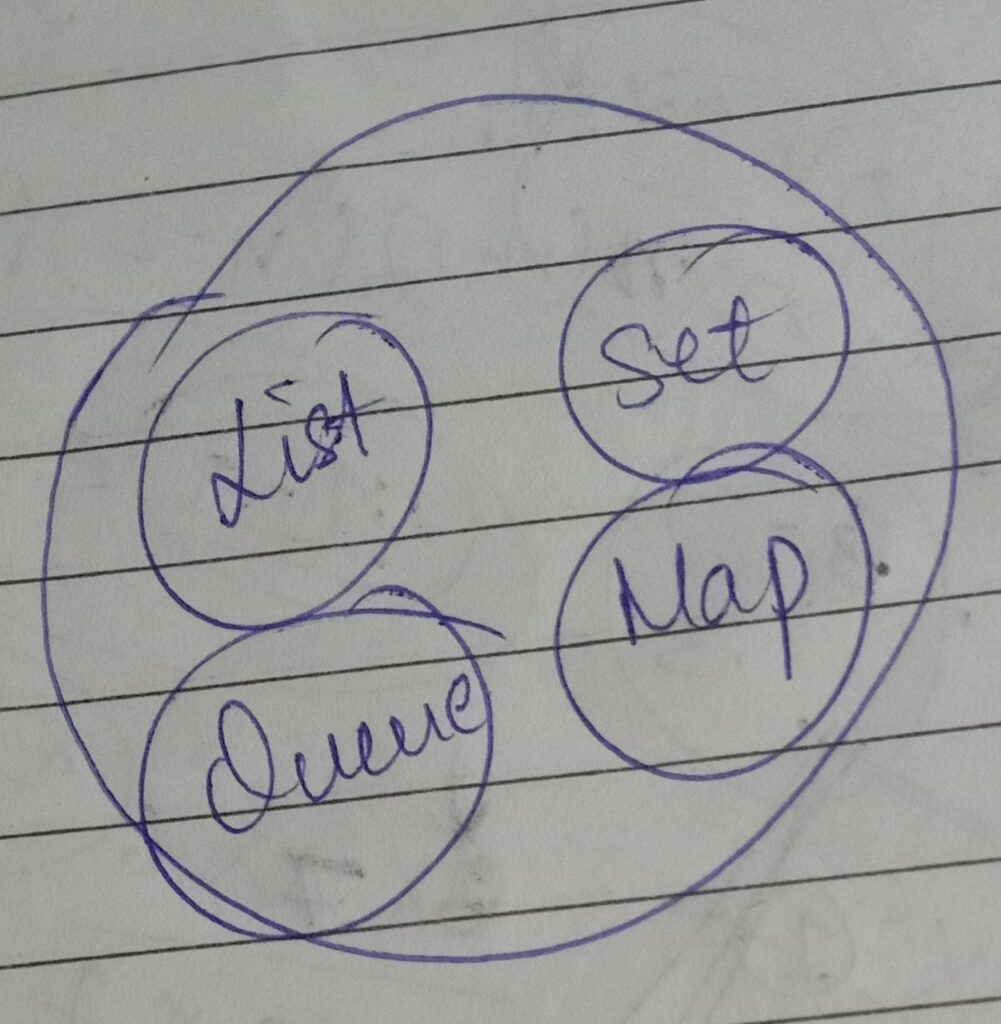In Java, collections are a way to organise and manage groups of objects. Think of it like organising a library with different book collections. You can categorise books based on genres, authors, or other criteria. . In Java, Java Collections Framework serves as containers that allow us to store and work with groups of objects. They provide a convenient way to manage and manipulate data effectively.
Java collections offer a variety of data structures and operations to handle data in a structured manner. They make it easier to add, remove, search, and process elements in groups. The main purpose of collections is to provide a standardized way of storing and accessing data, regardless of its size or complexity. They help us avoid the hassle of implementing low-level data structures and focus on solving problems efficiently.
Collections Framework In Java
The Java Collections Framework is a unified architecture that provides a set of Java interfaces, implementations, and algorithms to handle collections of objects in Java. It offers a comprehensive set of reusable data structures and algorithms to store, manipulate, and process groups of objects efficiently.
The main goals of the Java Collections Framework are:
- Consistency: The framework provides a consistent and standardized way to work with different types of collections. It ensures that similar operations can be performed on various collection types, promoting code reusability.
- Interoperability: The framework enables interoperability between different collections and algorithms. This means that you can easily switch between different collection implementations without changing your code.
- Extensibility: The framework allows you to create custom collection types by implementing the provided interfaces. This promotes flexibility and allows developers to tailor collections to their specific needs.
The Java Collections Framework includes several core interfaces, such as List, Set, Queue, and Map, along with their corresponding implementations. These interfaces define common methods and behaviours for working with collections, while the implementations provide concrete implementations based on different data structures.

Collections In Java Vs Collections Framework
While `Collections` refers to the concept of grouping objects, the `Collections Framework` provides a standardised and efficient implementation for working with collections in Java.
Some key differences are:
| Collections In Java | Collections Framework |
| Refers to a group of objects | Provides a structured framework |
| Individual instances or groups of objects | Hierarchy of interfaces and classes |
| General concept | Standardised approach |
| No predefined operations | Common operations and algorithms |
| No standardised data structures | Provides a variety of data structures |
| No standardised algorithms | Offers algorithms and utility methods |
| Less organised and consistent | Promotes code reusability and interoperability |
Advantages Of Collections Framework
Standardised and reusable: The Collections Framework provides a standardised and consistent set of interfaces, classes, and algorithms, making it easy to work with collections of objects. This promotes code reusability and simplifies development.
Efficient data structures: The framework offers a wide range of efficient data structures such as lists, sets, maps, and queues, which are optimised for specific use cases. These data structures provide efficient storage, retrieval, and manipulation of elements.
Type safety: The Collections Framework is designed to ensure type safety. It utilises generics to enforce compile-time type checking, allowing you to work with collections of specific types and preventing type-related errors at runtime.
Enhanced functionality: The framework provides a rich set of methods and algorithms for common collection operations such as searching, sorting, filtering, and transforming elements. This saves development time and effort by eliminating the need to implement such functionality from scratch.
Interoperability: Collections in the framework can easily be converted to arrays and vice versa, enabling seamless integration with existing code that relies on arrays. This promotes interoperability and allows for smooth migration from array-based solutions to collection-based solutions.
Iteration and traversal: The framework offers powerful iteration and traversal mechanisms, such as the Iterator and enhanced for-each loop, which simplifies the process of accessing and iterating over collection elements.
Hierarchy Of Collections Framework
There is a specific hierarchy that the Java Collections Framework adheres to. The java.util package contains all of the classes and interfaces found in the Collections Framework.
However, let’s first understand these words before learning about the Collections Framework in Java’s hierarchical structure.
- Class: A class is a grouping of objects of similar types. It is a collection interface implementation.
- Interface: An interface is an abstract data type. It occupies the highest spot in the hierarchy of the framework. It is a collection of associated empty-body methods, to put it simply. We can achieve (full) abstraction by using interfaces.
- extends: Using the keyword `extends`, you can create inheritance between two classes and two interfaces. In Java, the concept of inheritance describes the ability to build new classes on top of preexisting ones.
- Implements: The keyword `implements` is also used to create interface and class inheritance. An interface is implemented by a class.
As you can see Iterable Interface is the root interface of the Collections Interface and there are multiple interfaces that extend the Collections Interface like List, Queue, and Set. Also, you can see from the above hierarchy that there is a special interface called Map interface which does not extend the Collections Interface.
Iterator Interface
The Iterator interface in Java is a fundamental component of the Collections Framework. It provides a way to iterate over the elements of a collection and access them one by one.
The Iterator interface defines three essential methods:
`hasNext()`: This method checks if there are more elements available in the collection. It returns true if there are more elements, and false otherwise.
`next()`: This method retrieves the next element in the iteration and advances the iterator’s position. It returns the next element as an object of type E, where E represents the type of elements in the collection.
`remove()`: This method removes the last element returned by the next() method from the underlying collection. It is an optional operation and not all collections support element removal. If this method is called without a preceding next() call, or if it is called multiple times for the same element, it may throw an IllegalStateException.
Iterable Interface
The Iterable interface in Java is a key component of the Collections Framework since it is the root interface by which the Collections Interface extends. It is implemented by classes that represent a collection of elements and provide a way to iterate over those elements.
The Iterable interface is responsible for defining a single method:
Iterator<T> iterator(): This method returns an iterator over the elements of the collection. It allows you to obtain an Iterator object that can be used to traverse the elements in a collection in a sequential manner.
By implementing the Iterable interface, a class indicates that it supports iteration over its elements. This enables the use of the enhanced for loop (for-each loop) to iterate through the elements of the collection.
Collections Interface
The Collection interface is indeed the foundation of the Java Collections Framework. It provides a common set of methods and behaviors that are shared by all the collection types, including List, Queue, and Set.
The Collection interface is defined with the following declaration:
interface Collection<E>
Here, E represents the type of objects that the collection will hold. The Collection interface defines several important methods, including:
- add(E e): Adds the specified element to the collection.
- remove(Object o): Removes the specified element from the collection, if it exists.
- size(): Returns the number of elements in the collection.
- isEmpty(): Checks whether the collection is empty or not.
- contains(Object o): Checks whether the collection contains the specified element.
- clear(): Removes all elements from the collection.
By implementing the Collection interface, the classes that extend it (such as List, Queue, and Set) inherit these methods and can provide their own specific implementations.
The Collection interface serves as a contract that ensures consistent behavior across different collection types. It allows for polymorphic usage, where collections of different types can be treated uniformly using the common methods defined by the Collection interface.
Methods Of Collection Interface
The Collection interface in Java provides a set of methods that allow us to perform various operations on collections of objects. Let’s explore some of the important methods offered by the Collection interface:
| Methods | Description |
| public boolean add(E element) | Adds the specified element to the collection. |
| public boolean addAll(Collection c) | Adds all elements from the specified collection to this collection. |
| public boolean remove(Object o) | Removes the specified element from the collection, if present. |
| public boolean removeAll(Collection c) | Removes all elements from this collection that are also contained in the specified collection. |
| public boolean contains(Object o) | Checks if the collection contains the specified element. |
| public boolean containsAll(Collection c) | Checks if this collection contains all elements in the specified collection. |
| public boolean retainAll(Collection c) | Retains only the elements in this collection that are also contained in the specified collection. |
| public int size() | Returns the number of elements in the collection. |
| public boolean isEmpty() | Checks if the collection is empty. |
| public void clear() | Removes all elements from the collection. |
| public Iterator iterator() | Returns an iterator over the elements in the collection. |
| public Object[] toArray() | Returns an array containing all the elements in the collection. |
| public boolean equals(Object o) | Compares the specified object with the collection for equality. |
| public int hashCode() | Returns the hash code value for the collection. |
Interfaces That Extends Collections Interface
In the Java Collections Framework, several interfaces extend the Collection interface to provide additional functionalities and behaviours.
List Interface:
- The List interface extends the Collection interface and represents an ordered collection of elements.
- It allows duplicate elements and maintains the insertion order.
- Notable implementations of the List interface include ArrayList, LinkedList, and Vector.
Set Interface:
- The Set interface extends the Collection interface and represents an unordered collection of unique elements.
- It does not allow duplicate elements.
- Notable implementations of the Set interface include HashSet, TreeSet, and LinkedHashSet.
Queue Interface:
- The Queue interface extends the Collection interface and represents a collection that holds elements in a specific order for processing.
- It follows the FIFO (First-In-First-Out) order for elements.
- Notable implementations of the Queue interface include LinkedList and PriorityQueue.
Map Interface:
- The Map interface is not a subtype of the Collection interface but is an important part of the Java Collections Framework.
- It represents a mapping between keys and values, where each key is unique.
- Notable implementations of the Map interface include HashMap, TreeMap, and LinkedHashMap.
Conclusion
- Collections in Java provide a way to store and manipulate groups of objects.
- The Java Collections Framework is a comprehensive set of classes and interfaces that provide a standardised way to work with collections.
- Understanding the differences between collections and the collection framework helps in choosing the appropriate data structure for specific requirements.
- The collection framework offers benefits such as increased productivity, code reusability, and optimised performance.
- The hierarchy of the collection framework defines various interfaces and classes that represent different types of collections and their relationships.
- The Iterator and Iterable interfaces provide a way to iterate over collections and access their elements.
- The Collections interface serves as the foundation for the collection framework and provides basic operations for manipulating collections.
- The Collection interface defines a set of methods that are implemented by specific collection types.
- Several interfaces extend the Collection interface, such as List, Set, and Queue, each offering unique features and behaviours.

